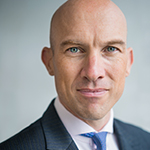Since 2016, the Swiss pure play has more than doubled its assets under management in Asia, reaching its peak in 2019, under the tutelage of its Asia chief Michael Blake.
In 2023, UBP garnered attention for its continued hiring, which has helped drive the bank’s plan to focus on the Greater China and Southeast Asia markets, Blake tells Citywire Asia in an interview.
‘2023 has been a year of investment and consolidation,’ said the Asia CEO. The region now accounts for around 14% of UBP’s group assets under management, which stand at CHF 140.6bn ($155bn).
Notably, new hires across geographies and segments have generated over half of the private bank’s net inflows in 2023, said Blake, in line with previous years. UBP primarily caters to clients with more than CHF 10m with the bank.
It has been a challenging year for the industry, punctuated by the gargantuan news of UBS’s rescue takeover of Credit Suisse and widespread restructuring at private banks across the region as players looked to refocus markets and segments. In many ways, it has not been an easy year to be a private banker or a private bank in Asia.
UBP has pushed through, cherry-picking senior, and junior bankers from across the industry. It has made hires from most rivals, including Standard Chartered, Credit Suisse, HSBC, BNP Paribas, EFG Bank and UOB, to name a few, and has consistently onboarded private bankers throughout the year.
‘Southeast Asian (Asean) markets provide an interesting opportunity for growth, which is why we are expanding our relationship manager coverage teams for these markets,’ said Blake, echoing views across the board. The South and Southeast Asian markets have also provided opportunities for private banks to draw the Middle East closer to the Asia business.
The recruitment in Hong Kong has been sustained, building on the momentum of prior years, he added.
Aside from geographical coverage, the bank has bolstered its investment services team, creating new roles for Hong Kong and Singapore heads to address local investment needs more effectively.
UBP is also developing its non-resident Indian proposition from Singapore, and enhancing its FX advisory services which have gained traction as clients pivoted to FX when other asset classes became more challenging.
Two-pronged China strategy
Over the past five years, two-thirds of the bank’s growth in Asia has come from the China market and it is easy to see why. China’s rapid wealth expansion, with projections of 20 million high-net-worth individuals (HNWIs) and 131,000 ultra-HNWIs by 2027, according to Knight Frank’s 2023 wealth sizing model, presents a huge opportunity for international wealth managers. UBP has approached this lucrative segment through the offshore centres of Hong Kong and Singapore, as well as an onshore strategy via Hainan.
In Singapore, the Greater China team will soon make up a fifth of the city-state’s total headcount by year-end, reflecting a significant acceleration of hiring this year. Apart from hiring senior RMs, UBP has also added two senior market heads for Greater China.
Last February, UBP established its Hainan office and obtained a qualified domestic limited partnership (QDLP) licence, allowing Chinese clients to invest in offshore assets. This follows the bank’s existing Shanghai QDLP programme for institutional clients. The Shanghai office was opened in 2014.
‘Our choice of Hainan is a reflection of its strategic importance as a free trade port and a supportive regulatory framework for financial services development.’
said Blake.
‘It also reflects local authorities’ desire to establish Hainan as a hub for family offices.’
He outlined China’s growth over several decades, from the rapid industrialisation in the 1990s to the current post-Covid phase, characterised by a maturing domestic economy and deglobalisation.
‘Domestically, moves to restructure the real estate sector and stimulate consumption are likely to be accompanied by a deepening of domestic capital and wealth management markets, as well as the continued role for international asset allocation,’ said Blake.
Building on this trend, he said the formula for success as a foreign bank has been to provide domestic investors with access to international asset allocation and global investment strategies through the QDLP programme.
Family Office foothold
Ultimately, what families need is a strong ecosystem to support their diverse needs, he added.
For instance, a major headache for families is bespoke reporting. It is difficult for many to consolidate reporting, calculate performance attribution and to synthesise data from different banks.
‘This can be a real challenge for families and often we are asked to help find the right solution provider,’ said Blake, explaining that offering such assistance can prove to be valuable to the bank’s clients.
UBP, like other banks, also sees opportunities in the fast-growing family offices segment.
Given that family offices are not homogenous, and no institution can be a ‘one-stop-shop’ for all their needs, Blake claims UBP’s family office proposition is more tailored than most.
UBP’s approach focuses on assisting family offices in two distinct areas: the mechanics of setting up a family office in Hong Kong or Singapore, including help with the application process, and addressing the growing demand for support in areas such as succession planning and family governance.
‘Some families develop a family constitution to define more systematically how the next generation gains exposure to the family business. Sometimes they benefit from an external adviser.’
said Blake.
A selective alts strategy
Private markets have gained popularity among high-net-worth investors, becoming more mainstream compared with a decade ago. To meet the rising demand for private client access to institutional-type investment opportunities, UBP has consistently invested in private markets strategies over the last six years globally.
Around a third of the bank’s clients who are eligible to invest in private markets already have some exposure. UBP provides half a dozen strategies per year and often offers direct investment opportunities which the bank originates or works with a partner to do so.
‘We tend not to offer blind funds, instead, we select a thematic in which we have high conviction and then invest directly,’ said Blake. Some private market thematics this year include infrastructure, airports, luxury hotels, fast-growing consumer areas, and technology.
UBP also provides access to larger private equity funds, but Blake noted that such offerings can become quite ‘commoditised’, with many of its peers providing similar strategies.
‘We take a view on the market and if we have high confidence in a specific theme, we put money to work,’ said Blake.
In the hedge funds space in Asia, Blake sees more opportunities, with UBP expanding its coverage with a hedge fund adviser in Hong Kong, recognising the potential for this asset class.
Ending the year with a bang
The bank is expected to end the year with net new money inflows, despite some impact from deleveraging due to rising rates, which has prompted clients to reduce their borrowing, according to Blake.
While he cautioned that the business mix has shifted significantly, with stronger net interest income offsetting weaker transactional activity, the regional business in Asia is expected to see net profit up year-on-year, the Asia CEO said.


 Michael Blake
Michael Blake